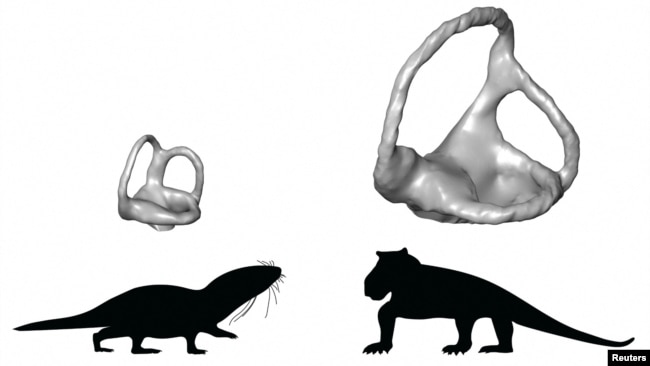とても興味深いですね〜。
早速、VOAで英語を学びましょう!!
哺乳類の起源を探るため、内耳の研究を開始(和訳)
Scientists Study Inner Ear to Determine Beginnings of Mammals
Aug01,2022
哺乳類は自分で体温を作り出し、体温をコントロールすることができます。このプロセスは内温性または温血として知られています。
※endothermy:(名詞)内温性【éndouθə̀ːmi】
warm-bloodedness:(warm-bloodedの名詞形) 温血
科学者たちは、哺乳類がほとんどすべての生態系を支配している可能性が高いのは、このためかもしれないと考えています。温血である哺乳類は、冷血動物よりも活動的です。凍てつく北極から灼熱の砂漠まで、さまざまな環境で生きることができるのです。そして、繁殖速度も速いのです。
温血か冷血かを示す軟部組織が化石に保存されていることはほとんどありません。そのため、古生物学者、つまり化石を研究する専門家は、哺乳類がいつ発達して温血動物に変化したかを正確に知らないのです。
※paleontologist:【pèɪliəntálədʒɪst】/ 古生物学者
科学者グループは、最近ネイチャー誌に発表した研究で、この疑問に答えようとしました。
リカルド・アラウージョ氏はリスボン大学の古生物学者です。アラウージョ氏と研究者グループは、管と呼ばれる内耳の構造の形と大きさを利用して、体温を研究することを提案しました。
外耳道を通る液体の動きは、体のバランスと動きを維持するのに役立ちます。冷血動物では、この体液が冷たく、厚いため、より広い管が必要です。一方、温血動物は耳の中の体液が少なく、管も細いのです。
研究チームは、体温が上昇し、動物がより活発になるにつれて、バランスと動きを維持するためにear canals外耳道の形と大きさが変化していることを示唆しました。
研究チームは、341匹の動物の外耳道を比較しました。この外耳道は、温血動物、つまりendothermy内温性が約2億3300万年前に出現したことを示すもので、これまでの推定値より数百万年遅いことになります。
アラウージョ氏は、「内温性は、我々人間を含む哺乳類の特徴です。体温が高いということは、人間のすべての行動や振る舞いを制御しているのです。」と言います。
しかし、温血を示した最初の生物は、公式には哺乳類とは見なされていません。哺乳類型シナプシッドと呼ばれるこれらの古代動物は、哺乳類にリンクした形質を持っていました。最初の真の哺乳類は、およそ3,000万年後に出現したと研究者は述べています。
温血であることの重要性
シカゴのフィールド博物館のケン・アンジエルチク氏は、この研究の共同責任者です。彼は、「現代の哺乳類のボディプラン、生理学、ライフスタイルの多くの側面において、内温性がいかに中心的であるかを考えると、古代の祖先において内温性がいつ進化したかは、本当に重要な未解決問題でした...」と言っています。
内温性は、背骨、呼吸システム、聴覚システムの変化など、哺乳類のボディプランの重要な要素が整った時に進化しました。
温血であることは、恐竜や空飛ぶ爬虫類が初めて地球上に出現した進化の重要な瞬間にも、哺乳類を助けました。そして、6600万年前の恐竜の大量絶滅の後、哺乳類がその座を引き継ぎました。現在の動物のうち、哺乳類と鳥類は温血です。
「我々の祖先が内温性を獲得したことが、最終的にギザのピラミッド建設やスマートフォンの開発につながったのではないかと考えるのは、 far-fetched突飛すぎるかもしれませんが、興味深いことです。」とアラウージョ氏は述べます。
※far-fetched【fárfétʃt】
「もし、我々の祖先が環境温度から独立しなかったら、これらの人類の偉業はおそらく不可能だったでしょう。」
Scientists Study Inner Ear to Determine Beginnings of Mammals
Mammals can produce their own body heat and control their body temperatures. This process is known as endothermy or warm-bloodedness.
Scientists believe that it may be the reason why mammals likely rule almost every ecosystem. Warm-blooded mammals are more active than cold-blooded animals. They can live in different environments, from the frozen arctic to the boiling desert. And they reproduce faster.
The soft tissues that would give information about warm- or cold-bloodedness are rarely preserved in fossils. So, paleontologists, or experts in the study of fossils, do not know exactly when mammals developed and changed into warm-blooded creatures.
A group of scientists tried to answer that question in a study recently published in Nature.
Ricardo Araújo is a paleontologist at the University of Lisbon. Araújo and a group of researchers proposed that the shape and size of the inner ear structures called canals could be used to study body temperature.
The movement of fluid through the ear canals helps the body to preserve balance and movement. This fluid in cold-blooded animals is cooler and thicker, meaning wider canals are needed. Warm-blooded animals have less ear fluid and smaller canals.
The research team suggested that as body temperature increased and the animals became more active, the shape and size of ear canals changed to preserve balance and movement.
The researchers compared ear canals in 341 animals. They said the ear canals showed that warm-bloodedness, or endothermy, appeared around 233 million years ago, millions of years later than some previous estimates.
Araújo said, "Endothermy is a defining feature of mammals, including us humans. Having a … high body temperature regulates all our actions and behaviors.”
But the first creatures that showed warm-bloodedness are not officially considered to be mammals. These ancient animals known as mammaliamorph synapsids had traits linked with mammals. The first true mammals, the researchers said, appeared roughly 30 million years later.
Importance of being warm-blooded
Ken Angielczyk of the Field Museum in Chicago is a co-leader of the study. He said, "Given how central endothermy is to so many aspects of the body plan, physiology and lifestyle of modern mammals, when it evolved in our ancient ancestors has been a really important unsolved question…”
Endothermy evolved at a time when important elements of the mammal body plan were falling into place, including changes to the backbone, breathing system, and hearing system.
Having warm-bloodedness also helped mammals at an important evolutionary moment when dinosaurs and flying reptiles first appeared on Earth. And mammals took over after the dinosaur mass extinction event 66 million years ago. Among today's animals, mammals and birds are warm-blooded.
"It is maybe too far-fetched, but interesting, to think that the onset of endothermy in our ancestors may have ultimately led to the construction of the Giza pyramids or the development of the smartphone," Araújo said.
"If our ancestors would have not become independent of environmental temperatures, these human achievements would probably not be possible."
Words in This Story
ecosystem – n. everything that exists in a particular environment
preserve – v. to keep (something) in its original state or in good condition
fossil – n. something (such as a leaf, skeleton, or footprint) that is from a plant or animal which lived in ancient times and that you can see in some rocks
feature – n. an interesting or important part, quality, ability, etc.
regulate – v. to set or adjust the amount, degree, or rate of (something)
trait – n. a quality that makes one person or thing different from another
aspect – n. a part of something
evolve – v. to change or develop slowly often into a better, more complex, or more advanced state : to develop by a process of evolution
far-fetched – adj. not likely to happen or be true
